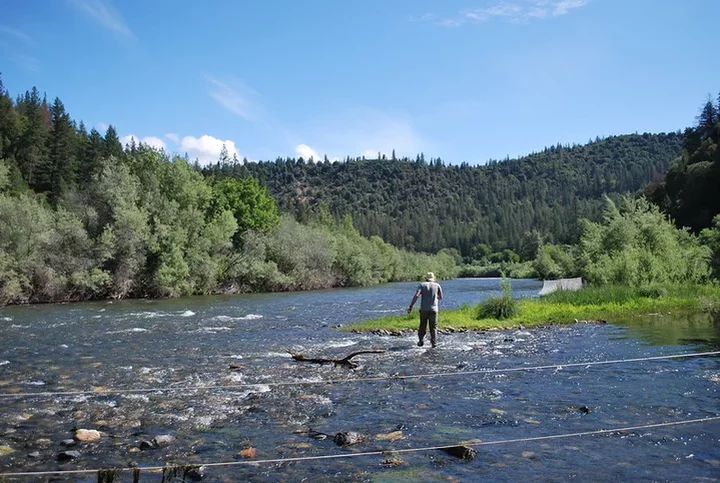Mainstem Klamath River juvenile Chinook salmon outmigration monitoring. | Photo via USFS, Creative Commons License CC BY 2.0
# # #
PREVIOUSLY:
- Yurok Tribe, Allies Get Federal Court Order Restoring Threatened Klamath River Water Flows
- Federal Plan to Cut Klamath River Flows Threatens Salmon Fishery, Local Tribes and Fishermen Warn
Press release from the Karuk and Yurok tribes:
Klamath Basin, CA – Late last year, the final regulatory approvals to remove four large dams on the Klamath River became the good news environmental story of the year. The fact that Tribes from remote communities along the California-Oregon border started a successful movement to remove four large dams suggests that America can indeed restore rivers, ensure wild salmon runs for future generations, and honor traditional cultures.
Unfortunately, officials from the Bureau of Reclamation and the Fish and Wildlife Service are turning this epic [victory] into a tragedy. Today, Department of Interior officials told tribes that flows to the river from the Klamath Irrigation Project would be reduced below the minimums described by the Biological Opinion that is supposed to govern Klamath Irrigation Project operations. These flow decreases will dewater salmon eggs putting [Endangered Species Act] ESA-listed coho salmon at further risk.
It should be noted that dam removal of the four dams will not impact the volume of water moving down the Klamath River; the operation of the Bureau’s 225,000 acre irrigation project further upstream dictates flow in the river along with accretions from Klamath River tributaries.
The Bureau claims that we are experiencing “extraordinary” drought which gives them authority to cut the flows. This is despite above average snowpack and the fact it’s currently snowing in the upper Basin. BOR claims that the water savings will be used to fill Upper Klamath Lake to benefit other endangered fish, the lost river, and short-nosed suckers.While the suckers are indeed at risk of extinction, there is no indication that the volume of Upper Klamath Lake factor into their demise. These long-lived fish have not reproduced successfully in 30 years, a period where lake levels have varied greatly.
“What the Bureau is not saying is that the water savings will make it more likely that irrigation deliveries will be available to water users,” according to Karuk Council Member Troy Hockaday. “This has more to do with potatoes than it does fish.”
“By presenting Klamath Basin tribes a false dilemma whereby they must choose between salmon in the river and suckers in the lake, Interior is continuing a long colonial tradition of cultivating division among tribal people while their natural resources are plundered to support an ecologically unsustainable industry. We should instead be focused on meaningful restoration of the wetlands that accommodated the needs of sucker and salmon for millennia that were sacrificed on the altar of manifest destiny,” said Yurok Vice Chairman Frankie Myers.
“The United States is on the threshold of the biggest fisheries success story in history. Dam removal will dramatically improve water quality and restore salmon access to hundreds of miles of historical habitat. It’s a step in the right direction for America’s efforts to meet its obligations to the Klamath’s Native people. But, if the bureaucrats at Interior have their way and deny salmon adequate flows for spawning, the dam removal effort will be fruitless and the sad history of colonization and genocide will continue for another generation,” said Karuk Chairman Russell ‘Buster’ Attebery.

CLICK TO MANAGE